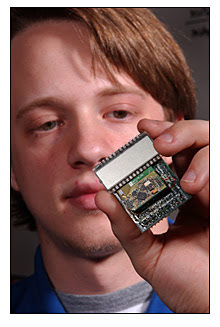GAINESVILLE, Fla., March 20, 2006 -- A team of University of Florida (UF) engineering students has designed a new sensor that they say could give grocers, florists and pharmacists a better way to monitor the quality of incoming products by telling them precisely how long before an item spoils or passes its expiration date.
The students designed and built a prototype of the new "smart" sensor, which can also record and wirelessly transmit information to retailers about when and where glitches occur as a product is being shipped, as part of a UF program that immerses students in entrepreneurial activities.

University of Florida electrical engineering senior Moishe Groger holds a “smart sensor” that can tell retailers who receive a shipment of goods how long it will be before they spoil or pass their expiration date. Groger and other students designed the sensor, which can also record when temperatures spike or other glitches occur as a product is being shipped, as part of a program that seeks to immerse engineering, business and law students in entrepreneurial activities. (March 9, 2006, photo by Kristen Bartlett/University of Florida)
“We think this sensor will make the perishable supply chain both safer and more efficient,” said Bruce Welt, an assistant professor of agricultural and biological engineering and a faculty adviser on the project. “Hopefully, that will translate into lower cost, better quality products for consumers.”
According to the UF engineers, many shippers today are reluctant to use disposable tags or labels that turn color or otherwise indicate if a product has passed its prime. The problems are that the tags don’t say when spoilage occurred, nor do they tell whether “fresh” goods will soon spoil. The former can make it hard to decide who is responsible when a spoiled product arrives. The latter can result in stores stocking merchandise that appears fine but quickly goes bad. Also, because products have different spoilage rates and temperatures, the tags have to contain different chemicals or otherwise be tailored to individual products. That raises their cost and increases the possibility of errors.
Shippers also rely on temperature monitors that indicate if, and by how much, a product’s recommended trucking temperature has been exceeded, the engineers said. That’s a problem because the devices may record excessive temperature near only one pallet of many pallets stacked together in one shipping container. That can force the entire shipment to be discarded even if most remained very near or within temperature guidelines.
“The reality is that for small violations of these temperatures, the products are fine but get thrown away anyway,” Welt said. With associate professor of electrical and computer engineering Bill Eisenstadt leading the technical development, six seniors majoring in engineering developed what Welt calls a “sensor platform” that is capable of tracking and interpreting not only temperature but also humidity, the shock of a product being dropped and other variables.
In the temperature setting, the half dollar-sized device checks the temperature. It then merges its readings with an algorithm, or set of computer instructions, that electronically mimics the spoilage characteristics of milk, fish, flowers or whatever product is being shipped. The device can communicate its results constantly and in real time via a wireless transmitter, allowing retailers with laptop computers to instantly check the status of an incoming product, learning not only whether it is fresh but also how long it has until it spoils -- and at what point, if any, temperatures spiked above normal during shipping.
A retailer would know that “this load of fish is pristine, that it came right off the boat and that it has several days before it goes bad,” Eisenstadt said. The engineering student team is working with UF business and law students to patent and market the device as part of the university’s Integrated Technology Ventures program, which seeks to immerse students in entrepreneurial activities surrounding UF technologies. The three-year-old program has spun off a Gainesville-based company that sells a device for monitoring groundwater contamination.
Eisenstadt said one hurdle for marketing the sensor is finding the right combination of features and cost. The current sensor platform is designed for markets with stringent shipping standards such as pharmaceuticals but can be adapted and simplified to meet other needs. The Integrated Technology Ventures program is operated by the UF Office of Technology Licensing, the UF Center for Entrepreneurship and Innovation and the Integrated Product and Process Design Program. Faculty and students are organized as a virtual company. The company is lead by a CEO and includes a business development of business students, a technology team of engineers and a legal team of UF law students.
Learning to work with colleagues in different disciplines is a big part of the challenge of the program, students said. “Everyone has to learn everyone else’s field in six months,” said Michelle Wasserlauf, a senior majoring in industrial engineering. “The engineers have to communicate with the business people, and at the same time we have to learn all the legal aspects of the project.”
Eistenstadt said a patent application has been filed for the sensor device, and that the team recently received a $15,000 grant to continue developing the technology this summer.
For more information, visit: www.ufl.edu